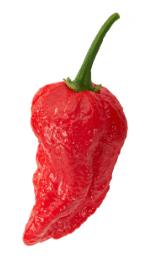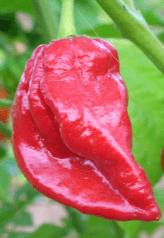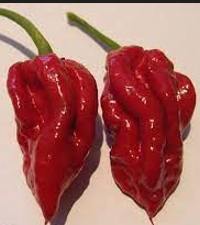Naga viper pepper
Overview:
 The Naga Viper is one of the hottest peppers in the world. The Naga Viper was developed in England by Gerald Fowler of the Chilli Pepper Company, located in Cark, Cumbria.
The Naga Viper is one of the hottest peppers in the world. The Naga Viper was developed in England by Gerald Fowler of the Chilli Pepper Company, located in Cark, Cumbria.
This pepper is said to be an unstable hybrid resulting from a combination of three of the world’s hottest chilies: the Naga Morich, the Bhut Jolokia, and the Trinidad Scorpion.
This pepper can reach up to 1,382,000 Scoville Heat Units (SHU), making it significantly hotter than a jalapeño.
It’s not just about the heat, though; the Naga Viper also has a fruity and slightly sweet flavor, though the extreme spiciness can overshadow it.
If you’re thinking of trying it, be cautious—just a small amount can add intense heat to dishes, and it’s best used sparingly.
Hottest chili pepper in the world
As of now, the Carolina Reaper holds the title of the hottest chili pepper in the world.
It averages around 1.6 million Scoville Heat Units (SHU), with some individual peppers reportedly exceeding 2.2 million SHU.
The Carolina Reaper is known for its extreme heat and distinctive fruity flavor, although the intense spiciness can easily overwhelm other flavors.
It’s used mainly in sauces and as a spicy ingredient in cooking, but it’s not for the faint of heart. Always handle it with care and use gloves if you’re preparing it.
Naga Viper vs Ghost Pepper
Naga Viper
- Heat Level: Around 900,000 to 1,382,000 Scoville Heat Units (SHU), though it can vary.
- Origin: England; it’s a hybrid created by crossing the Naga Morich, Bhut Jolokia, and Trinidad 7 Pot.
- Flavor: Fruity and slightly sweet with an intense heat. The heat can build up quickly and might be overwhelming.
- Usage: Often used in hot sauces and as a spicy ingredient in cooking. Due to its extreme heat, it should be used sparingly.
Ghost Pepper (Bhut Jolokia)
- Heat Level: Typically around 800,000 to 1,041,427 SHU.
- Origin: Northeastern India, particularly Assam, and Bangladesh.
- Flavor: Fruity with a bit of smokiness. It has a complex flavor profile, but the heat can quickly dominate.
- Usage: Widely used in hot sauces, curries, and as a spicy ingredient in various dishes. It’s also known for its intense, lingering heat.
Comparison:
- Heat: The Naga Viper can be slightly hotter on average than the Ghost Pepper, but both are extremely spicy.
- Flavor Profile: Both have a fruity flavor, but the Ghost Pepper might have a bit more smokiness. The Naga Viper’s flavor might be more subdued by its intense heat.
- Origin and Use: The Ghost Pepper has a more established reputation and history, while the Naga Viper is a more recent creation.
Naga Viper Pepper vs Carolina Reaper
Naga Viper
- Heat Level: Approximately 900,000 to 1,382,000 Scoville Heat Units (SHU).
- Origin: England; a hybrid pepper created by crossing the Naga Morich, Bhut Jolokia (Ghost Pepper), and Trinidad 7 Pot.
- Flavor: Fruity and slightly sweet, with a complex flavor profile overshadowed by intense heat. The heat builds gradually and can be overwhelming.
- Usage: Commonly used in hot sauces and culinary applications where extreme heat is desired. Use sparingly to avoid overpowering dishes.
- Heat Level: Averaging around 1.6 million SHU, with some individual peppers reportedly exceeding 2.2 million SHU.
- Origin: South Carolina, USA; developed by Ed Currie of PuckerButt Pepper Company.
- Flavor: Fruity and slightly nutty with a distinct sweetness, though the intense heat can mask these flavors. The Carolina Reaper is known for its sharp, biting heat that often causes a “slow burn.”
- Usage: Widely used in hot sauces, spicy foods, and as a challenge for heat enthusiasts. It’s best used in very small amounts due to its extreme heat.
Comparison:
- Heat: The Carolina Reaper is generally hotter than the Naga Viper, with its average heat level significantly exceeding that of the Naga Viper. The Reaper holds the title of the hottest chili pepper in the world.
- Flavor Profile: Both peppers have fruity notes, but the Reaper’s heat is often described as more intense and piercing. The Naga Viper’s heat builds more gradually, whereas the Reaper’s heat is sharp and persistent.
- Origin and Recognition: The Carolina Reaper has a more established record for its extreme heat and has been officially recognized as the hottest pepper by the Guinness World Records. The Naga Viper, while extremely hot, does not hold this official title.
Naga viper pepper recipes
Naga Viper Hot Sauce
Ingredients:
- 4 Naga Viper peppers, stems removed
- 2 cloves garlic, minced
- 1 cup vinegar (white or apple cider)
- 1/2 cup water
- 1 teaspoon salt
- 1 tablespoon sugar (optional, for a touch of sweetness)
Instructions:
- Prepare Peppers: Wear gloves and carefully chop the Naga Viper peppers. Remove seeds if you want to reduce heat slightly.
- Cook: In a saucepan, combine the peppers, garlic, vinegar, water, and salt. Bring to a simmer over medium heat and cook for about 10 minutes.
- Blend: Allow the mixture to cool slightly, then blend until smooth. You can use a blender or an immersion blender.
- Strain: For a smoother texture, strain the sauce through a fine mesh sieve.
- Store: Transfer the sauce to sterilized bottles or jars. Store in the refrigerator for up to 6 months.
Spicy Naga Viper Chili
Ingredients:
- 1 lb ground beef or turkey
- 1 onion, chopped
- 2 cloves garlic, minced
- 1 Naga Viper pepper, finely chopped (use half if you’re unsure about the heat level)
- 1 can (14.5 oz) diced tomatoes
- 1 can (15 oz) kidney beans, drained and rinsed
- 1 cup beef or vegetable broth
- 1 tablespoon chili powder
- 1 teaspoon cumin
- Salt and pepper to taste
Instructions:
- Cook Meat: In a large pot, brown the ground meat over medium heat. Drain any excess fat.
- Add Vegetables: Add the onion, garlic, and Naga Viper pepper to the pot. Cook until the onion is soft and translucent.
- Simmer: Stir in the diced tomatoes, kidney beans, broth, chili powder, cumin, salt, and pepper. Bring to a boil, then reduce heat and simmer for 30 minutes, stirring occasionally.
- Adjust Seasoning: Taste and adjust seasoning if necessary. Serve hot with your favorite chili toppings.
Naga Viper Salsa
Ingredients:
- 2 Naga Viper peppers, finely chopped (remove seeds for less heat)
- 4 ripe tomatoes, diced
- 1/2 red onion, finely chopped
- 1/2 cup fresh cilantro, chopped
- Juice of 1 lime
- Salt to taste
Instructions:
- Mix Ingredients: In a bowl, combine the chopped Naga Viper peppers, tomatoes, red onion, and cilantro.
- Season: Add lime juice and salt to taste. Mix well.
- Chill: Let the salsa sit for at least 30 minutes to let the flavors meld. Serve with chips or as a topping for grilled meats.
Naga Viper Infused Oil
Ingredients:
- 1/4 cup Naga Viper peppers, chopped (use gloves)
- 1 cup olive oil
- Instructions:
- Heat Oil: In a saucepan, gently heat the olive oil over low heat.
- Infuse: Add the chopped Naga Viper peppers and let them infuse in the oil for about 15-20 minutes. Do not let the oil reach smoking point.
- Cool and Strain: Allow the oil to cool, then strain out the pepper pieces.
Tips for Handling Naga Viper Peppers:
- Wear Gloves: Always wear gloves when handling Naga Viper peppers to avoid skin irritation.
- Ventilation: Work in a well-ventilated area or use an exhaust fan, as the fumes from the peppers can be intense.
- Taste Cautiously: When adding Naga Viper peppers to recipes, start with a small amount and taste as you go. Their heat can build up quickly.
Naga viper pepper plant
 Growing a Naga Viper pepper plant can be a rewarding but challenging experience due to its extreme heat and specific growing needs.
Growing a Naga Viper pepper plant can be a rewarding but challenging experience due to its extreme heat and specific growing needs.
Choosing and Preparing Seeds
- Purchase seeds from a reputable source. Naga Viper seeds can be found online or from specialty pepper seed suppliers.
- Soak the seeds in water for 24 hours before planting to improve germination rates.
Germination
- Begin by sowing seeds indoors 8-12 weeks before the last frost date in your area. Use seed-starting trays or pots with a seed-starting mix.
- Keep the soil temperature between 75-85°F (24-29°C) for optimal germination. A heat mat can help maintain the necessary warmth.
- Provide plenty of light using grow lights or a sunny window. Peppers need 14-16 hours of light daily to grow strong seedlings.
Transplanting
- Once seedlings have at least two sets of true leaves and the outdoor temperatures are consistently warm, they can be transplanted.
- Transplant seedlings outdoors after all danger of frost has passed and when soil temperatures are consistently above 60°F (15°C).
- Space plants about 18-24 inches apart in well-drained soil.
Soil and Location
- Naga Viper peppers prefer well-drained, loamy soil with a pH of 6.0 to 7.0. Amend soil with compost to improve fertility and drainage.
- Choose a location that receives full sun, ideally 6-8 hours of direct sunlight per day.
Care and Maintenance
- Keep the soil consistently moist but not waterlogged. Water deeply and allow the top inch of soil to dry out between waterings.
- Feed plants with a balanced fertilizer every 2-4 weeks. Switch to a high-potassium fertilizer once flowers start to develop to promote fruiting.
- Remove any side shoots to encourage a single, strong main stem. This helps the plant focus its energy on producing high-quality peppers.
Pollination
- Naga Viper peppers are typically self-pollinating, but gently shaking the plants can help increase pollination rates and fruit set.
Harvesting
- Peppers can be harvested when they reach full size and are a vibrant red color. They will continue to ripen off the plant if picked slightly under-ripe.
- Use gloves when handling ripe peppers, as the oils can irritate the skin. Cut peppers from the plant with scissors or pruning shears to avoid damaging the plant.
Pest and Disease Management
- Watch for common pests like aphids, spider mites, and whiteflies. Neem oil or insecticidal soap can help manage these pests.
- Keep an eye out for fungal diseases like powdery mildew and blight. Good air circulation and proper watering practices can help prevent these issues.
Winter Care (If Growing Indoors)
- If growing Naga Viper peppers indoors or in a greenhouse, maintain consistent temperatures and humidity levels. Peppers can be overwintered indoors by providing adequate light and warmth.
Tips for Success
- Naga Viper peppers can take 90-120 days to mature from transplanting, so patience is key.
- Be cautious when handling the peppers, and avoid touching your face or eyes after handling them.
